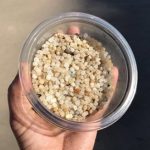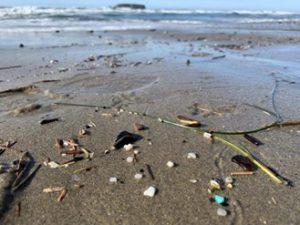Nurdles-the tiny plastic that’s become a big problem
Nurdles are micro plastic – tiny plastic pellets roughly the size of a lentil that although are tiny, are causing serious pollution to our oceans. For a long while, they have been used in the process of making all things plastic, such as bottle tops, and food containers. Unfortunately, during the manufacturing process of these items, nurdles are lost and end up entering our ocean through storm drains, spillages and other methods. Within the EU alone, it is estimated that every day up to 23 billion nurdles end up joining those already in the ocean. This is an roughly equal to an astounding 15 billion plastic bottles!

Nurdles often attract chemicals to their surface © K Berger/PA
First recorded in 1970, the nurdle problem is now so vast that nurdles have been noted on every continent except for Antarctic. As the nurdle pollution grows, scientists and conservationists are realising the negative impact that these tiny plastics are having on marine life around the globe. There are now calls for nurdle pollution to be more closely monitored. However, one of the biggest challenges is that, like other micro plastics, the tiny size of nurdles makes them difficult to remove once in the environment.

Nurdles on a beach ©Oceanblueproject/Ana Mexia
In addition, the small size of nurdles means they are easily consumed in large amounts by marine animals, and so, quickly accumulate in large numbers within food webs. For example, turtles, dolphins and seabirds are all examples of species that have had deaths linked to these micro plastics. Worse still, nurdles also readily absorb chemicals used within plastic production in large quantities. These chemicals are then leeched into the surrounding environment once the nurdles enter the ocean. The released toxins can also directly harm the wildlife’s biological systems as the plastics build up internally. This will then further build up and impact different levels of the food web. Studies have even indicated that micro plastics like nurdles are found within the seafood we eat, and more shockingly, since 2020 onwards, have been found inside us humans!
Recent research has indicated that newer nurdles are also more harmful to the environment then older ones, as they contain higher amounts of the chemicals that are able to leech into ocean. Luckily, things are being set in motion that will hopefully change the population’s outlook on nurdles. This includes legislative proposals and campaigns in aid of providing more legislation and restrictions over the levels of nurdle pollution we currently see. Every new restriction and method of monitoring and reducing nurdle levels and other micro plastics within the ocean is a splash in the right direction.
We also know that topics like this can sometimes be overwhelming, but there are still lots we can do to tackle all kinds of pollution to help improve our marine environment, remember, every little bit makes a difference! There are lots of movements and projects spreading the word about nurdles and volunteer activities to get involved in – carrying out nurdle hunts and reporting findings. The Nurdle Hunt organisation is one of the most well-known out there and you can find out more about it here
You can download a handy Nurdle Hunt ID sheet from their website which is packed full of great pictures and information!
